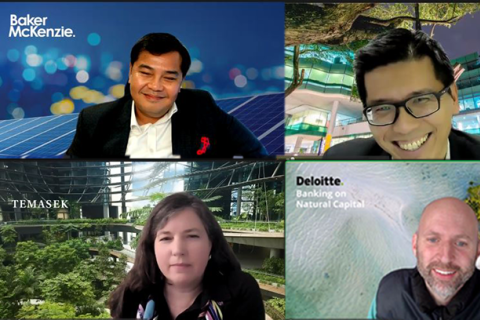
By Alvin Lee
SMU Office of Research – Indonesia is the biggest palm oil producer in the world, with the U.S. Department of Agriculture crediting it with a nearly 60 percent share of global production. The versatility of palm oil – it is used in cosmetics, food products, detergents – is a key reason for its popularity, which translates to a global market worth some US$60 billion that is predicted to reach US$100 billion by 2030.
Increasingly, palm oil is also used to make biodiesel. While that might reduce the use of fossil fuels and therefore be viewed as being environmentally and sustainability friendly, the somewhat murky reputation of palm oil gives consumers pause despite it producing “more oil per land area than any other equivalent vegetable oil crop”.
“There was a lot of conflict and excitement at the same time,” says Ishani Mukherjee, Singapore Management University (SMU) Associate Professor of Public Policy. “On the one hand, biodiesel could be championed as an alternate fuel and a move away from fossil fuels, but on the other hand the ecological issues associated with palm oil as a feedstock were something we could not ignore.”
She adds: “What was revealed at that time were these massive regulatory gaps in how the sustainability of biodiesel was being governed. So, my research came along at that point. I looked at three main policies that were out there to check the sustainability of this product in Indonesia. I realised that there was a lot of leakage happening across the supply chain that was undermining the sustainability of the product.”
Professor Mukherjee’s recent paper “Fueling green connections: Networked policy instrument choices for sustainability regulation”, which is based on her previous fieldwork, examined the environmental sustainability of Indonesia’s biodiesel governance regime, and won the Review of Policy Research Best Article Prize for 2022. The three main policies that she looked at were:
- The Indonesian Sustainable Palm Oil (ISPO) certification standard, otherwise known as Ministry of Agriculture Regulation No. 19/2011. ISPO is a re-establishment of existing multi-ministerial regulations into a dedicated package that streamlines national sustainability certification efforts;
- Ministry of Energy Regulation No. 32/2008, the national mandates on biodiesel use that requires a progressive blend of biodiesel and diesel to be supplied across the nation; and
- The Basic Forestry Law (Law No. 41/1999) that established a classification system for national forests which is used to site oil palm plantations for biodiesel production.
These three laws “either have direct effects on sustainability as part of feedstock production upstream, indirectly impact the environment by involving the final commodity downstream or have sustainability ‘spillovers’ across sectors”, Professor Mukherjee wrote in the paper.
Subsystems, interconnectedness, and cohesion
She then looked into the biofuel regulatory subsystem in Indonesia.
“A policy subsystem… is the main unit for policy scholars to study and draw the boundaries around any issue area,” Professor Mukherjee explains, adding that “the subsystem idea allows us to look at a policy issue and all the actors, institutions and ideas that occupy that space.
“For example, the biodiesel policy subsystem unites different ministries (agriculture, forestry, energy) with different non-governmental organisations (environmental and social), and different industries (palm oil and biofuel) and other actors, that the term ‘ministry’ or the word ‘sector’ or ‘industry’ would not fully capture.”
She then measured the ‘interconnectedness’ of the subsystem, using the UCINET software to pick out actors’ common presence at meeting and conferences, which “gave an idea of how frequently they were meeting and talking” about the issues at hand. High interconnectedness may include routine meetings, information transfer, or contractual obligations, in this case relating to biodiesel policy.
Professor Mukherjee also looked at the ‘cohesion’ between the actors by quantifying how much they agreed on the various issues. To achieve this, she went through proceedings, documented records and meeting minutes to find instances where attendants agreed (or disagreed) on various issues, and followed up with extensive interviews.
The result of this network analysis: Indonesia’s biofuel subsystem had high interconnectedness and low cohesion, which means the many parties met regularly but they often did not agree on what should be done to regulate it sustainably.
“Biodiesel as renewable energy and palm oil are contentious topics. They tend to polarise people… so that makes it easy to identify cohesion or the lack thereof,” notes Professor Mukherjee. “Sustainability needs to be achieved across the supply chain. That's what wisdom about sustainability policy tells us because there's no point in having piecemeal policy tools if there are so many leakages across the supply chain.
“I looked at the three main policies governing biodiesel sustainability, and I saw that they were actually governing sustainability at three different chunks of the supply chain. Those chunks reflected patchiness in the policy network. There were actors clumped together on the downstream of the supply chain. Another clump of actors appeared in the middle of the supply chain. Another clump appeared in the beginning, more upstream end. That was a very telling example: if we have these clumps appearing in a network, each of those clumps will frame its sustainability priorities differently.”
Research findings and lessons
According to Bressers and O’Toole’s 1998 work, “The Selection of Policy Instruments: A Network-Based Perspective”, which the biodiesel study updates, policymakers in subsystems with high interconnectedness and low cohesion – one of four combinations of high/low interconnectedness and cohesion – would produce policies or regulations with characteristics represented by parentheses below:
- Provision or withdrawal of resources (Limited withdrawal);
- Freedom of choice to apply (Absent);
- Unilateral or bilateral action on target groups (Many bi- or multilateral arrangements);
- Normative appeal (Present);
- Proportionality (Present, Individualised); and
- Role of policy makers in implementation (Implementation by a policy maker or affiliated organisations)
Professor Mukherjee compared how the three Indonesian biofuel governance policies matched up to a preference for policy characteristics aligned with high interconnectedness and low cohesion, finding mixed results.
“Bressers and O’Toole’s theory has been tested in different contexts, but despite those different contexts, they have shown similar results,” Professor Mukherjee elaborates, referring to policies in a high interconnectedness/low cohesion subsystem would have the same characteristics. “Here, it is not the case. The beauty of the theory is that you should be able to test it in any subsystem [and get the same results].
“With regard to the resource-based policy variable, Indonesia’s biofuel governance follows what we would expect from a poor alignment of goals – that is, a focus on punitive resource withdrawal (i.e., No. 1),” she notes. “In further agreement with the hypothesis, this punitive tendency is mediated by Indonesia’s high interconnectedness, resulting in the incentives of the national mandate and the loosening of the withdrawal capacity of forestry laws. Across other policy variables, however, overall consistency is lacking – except for the national mandate (i.e., No. 2), for which most of the six variables are aligned with the network structure.”
One feature of Indonesia’s biodiesel governance is the concentration of powerful central policy actors. Specifically, the central actors in this case are government agencies in the form of the ministries of agriculture and energy that affect the design of the policies. As a result, a more nuanced approach is necessary, incorporating centrality, to evaluate the impact of policy networks on sustainability governance, says Professor Mukherjee.
“Firstly, the degree of centrality in policy networks should be tested as an explanatory variable of policy choice – that is, to what extent are certain parts of the network concentrated in the centre and thereby given favourable positions to formulate policy end up impacting what elements get included in the design of a policy instrument?
“Secondly, the study acknowledges dominance as a missing factor in the research. When singular actors are dominant in a network of high interconnectedness, policy selection may resemble conditions of low interconnectedness, making it an important factor to account for.”
Back to Research@SMU May 2023 Issue
See More News
Want to see more of SMU Research?
Sign up for Research@SMU e-newslettter to know more about our research and research-related events!
If you would like to remove yourself from all our mailing list, please visit https://eservices.smu.edu.sg/internet/DNC/Default.aspx

